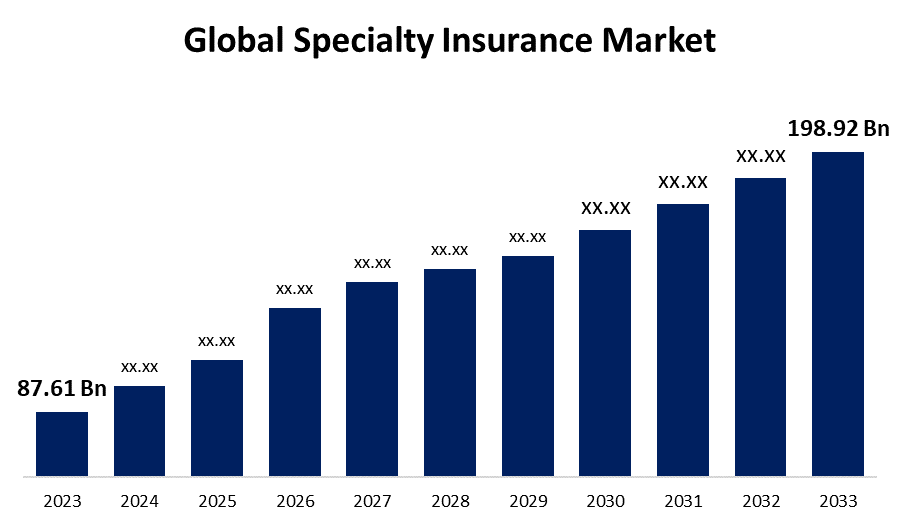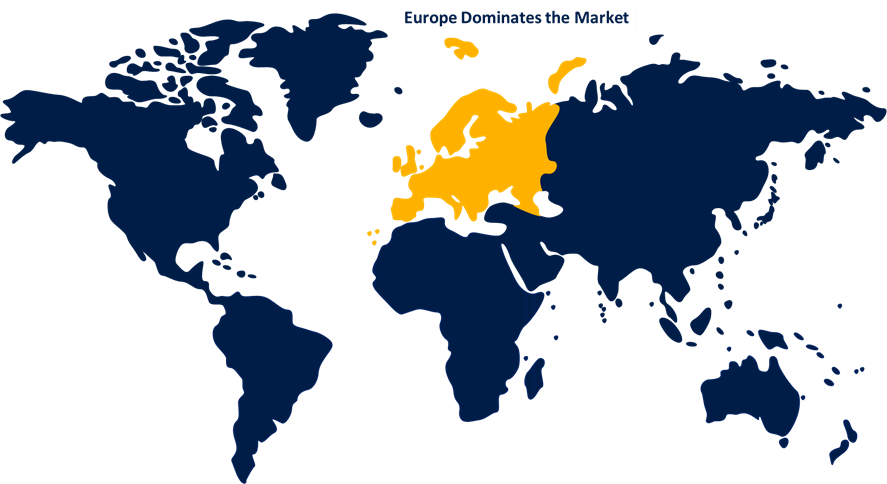Global Long-Term Care Insurance Market Size, Share, and COVID-19 Impact Analysis, By Service (Nursing Care, and Home Healthcare), By Payer (Out-of-Pocket and Public), and By Region (North America, Europe, Asia-Pacific, Latin America, Middle East, and Africa), Analysis and Forecast 2023 - 2033
Industry: Banking & FinancialGlobal Long-Term Care Insurance Market Insights Forecasts to 2033
- The Global Long-Term Care Insurance Market Size was Valued at USD 24.17 Billion in 2023
- The Market Size is Growing at a CAGR of 14.01% from 2023 to 2033
- The Worldwide Long-Term Care Insurance Market Size is Expected to Reach USD 89.69 Billion by 2033
- Asia Pacific is Expected to Grow the fastest during the forecast period.

Get more details on this report -
The Global Long-Term Care Insurance Market Size is Anticipated to Exceed USD 89.69 Billion by 2033, Growing at a CAGR of 14.01% from 2023 to 2033.
Market Overview
Long-term care (LTC) insurance offers more flexibility and options than many public assistance operations, such as Medicaid. It covers nursing-home care, home-health care, and personal or adult daycare for people 65 years of age or older or with a chronic or disabling condition that requires constant supervision. The global long-term care insurance (LTCI) market in the insurance industry is committed to giving those in need of long-term care due to age-related disorders, disabilities, or chronic illnesses financial security and support. Expenses for non-medical and medical services provided in a variety of settings, including assisted living facilities, nursing homes, and private homes, as well as long-term care services, including assistance with dressing, eating, bathing, and moving around, are covered by this kind of insurance. Due to evolving family dynamics and longer life expectancies, there is a growing demand for financial solutions to lower the potentially high costs of long-term care services. A specified benefit duration, which can range from a few years to a lifetime, is typically included in LTCI policies to ensure that payouts keep up with rising healthcare costs over time. Options for protecting against inflation might also be included. In the market for long-term care insurance (LTCI), insurers are required to make accurate predictions about the likelihood that policyholders will require long-term care and the associated costs.
Report Coverage
This research report categorizes the market for the global long-term care insurance market based on various segments and regions forecasts revenue growth and analyzes trends in each submarket. The report analyses the key growth drivers, opportunities, and challenges influencing the global long-term care insurance market. Recent market developments and competitive strategies such as expansion, product launch, and development, partnership, merger, and acquisition have been included to draw the competitive landscape in the market. The report strategically identifies and profiles the key market players and analyses their core competencies in each sub-segment of the global long-term care insurance market.
Global Long-Term Care Insurance Market Report Coverage
| Report Coverage | Details |
|---|---|
| Base Year: | 2023 |
| Market Size in 2023: | USD 24.17 Billion |
| Forecast Period: | 2023 - 2033 |
| Forecast Period CAGR 2023 - 2033 : | 14.01% |
| 2033 Value Projection: | USD 89.69 Billion |
| Historical Data for: | 2019 - 2022 |
| No. of Pages: | 232 |
| Tables, Charts & Figures: | 110 |
| Segments covered: | By Service, By Payer, By Region. |
| Companies covered:: | Genworth, John Hancock, Aviva, Allianz, Aegon, Dai-ichi, AXA, China Life, Prudential, Generali Italia, Unum Life, Sumitomo Life Insurance, Northwestern Mutual, and Others |
| Pitfalls & Challenges: | COVID-19 Empact, Challenge, Future, Growth, & Analysis |
Get more details on this report -
Driving Factors
The growing number of elderly people is a major global concern, which has put more pressure on governments to provide services. These governments are reforming their healthcare systems to offer senior citizens the services they require at reasonable costs. The market is expected to grow during the forecast period, driven by the Medicare and Medicaid systems' support of long-term care (LTC) for the elderly. Technological developments in healthcare delivery are another factor driving the industry's expansion. At first, the management mostly used durable medical equipment, such as wheelchairs, walkers, and safety blankets. Advanced, user-friendly products and services like telemedicine, mobile health apps, and internet-enabled home monitoring are expected to drive the market throughout the projection period.
Restraining Factors
Many rumors and second thoughts about buying these long-term care policies have surfaced following the increase in prices and coverage. Due to premiums are rising, many people who are living on low incomes are unable to afford such medical security. The monthly or annual premium rates are too high for retired military members, despite the fact that it is primarily beneficial to the elderly. Instead of paying more rates for insurances with fewer benefits, people opt not to purchase this insurance. This is expected to limit the market's growth for long-term care insurance.
Market Segmentation
The global long-term care insurance market share is segmented into service and payer.
- The nursing care segment dominates the market with the largest market share through the forecast period.
Based on the service, the global long-term care insurance market is segmented into nursing care and home healthcare. Among these, the nursing care segment dominates the market with the largest market share through the forecast period. This is attributed to the growing demand from developing nations and the preference for caring for the elderly. The need for nursing care is expanding due to the aging population and the rising incidence and prevalence of chronic illnesses like cancer, Alzheimer's disease, and heart difficulties. The use of home healthcare is most prevalent among those over 65, those newly released from hospitals, persons with mental health issues, new moms, and those who wish to provide their parents with in-home medical care. The need for cost-effective, individualized long-term care at home is driving the expansion of the home healthcare market. Due to rising healthcare costs, more people who require care now receive their care at home.
- The public segment accounted for the largest revenue share through the forecast period.
Based on the payer, the global long-term care insurance market is segmented into out-of-pocket and public. Among these, the public segment accounted for the largest revenue share through the forecast period. The main cause of this substantial segment share is the strong governmental spending that has been seen, particularly in the US and Europe. One notable example is found in the United States, where Medicaid pays for over 50% of long-term care costs, however, state-by-state differences exist.
Regional Segment Analysis of the Global Long-Term Care Insurance Market
- North America (U.S., Canada, Mexico)
- Europe (Germany, France, U.K., Italy, Spain, Rest of Europe)
- Asia-Pacific (China, Japan, India, Rest of APAC)
- South America (Brazil and the Rest of South America)
- The Middle East and Africa (UAE, South Africa, Rest of MEA)
North America is anticipated to hold the largest share of the global long-term care insurance market over the predicted timeframe.

Get more details on this report -
North America is anticipated to hold the largest share of the global long-term care insurance market over the predicted timeframe. The wide availability of long-term care facilities, an ever-improving reimbursement system, and supportive government regulations for this industry are some of the main causes of this regional people in need of long-term care services, such as assisted living facilities, nursing homes, and home healthcare. In addition, the nation's extensive healthcare spending and well-established healthcare infrastructure support the accessibility and availability of a large selection of long-term care options.
Asia Pacific is expected to grow at the fastest CAGR growth of the global long-term care insurance market during the forecast period. As a result of both growing healthcare expenses and an aging population. It is anticipated that as the population ages and the need for long-term care services rises, so will the need for long-term care insurance. Demand for long-term care insurance is being driven by an increase in the number of persons with chronic illnesses in the Asian region. In addition, customers are becoming increasingly interested in long-term care insurance due to the growing expense of healthcare. Additionally, the governments of many Asian nations offer financial incentives to entice citizens to get long-term care insurance.
Competitive Analysis:
The report offers the appropriate analysis of the key organizations/companies involved within the global long-term care insurance market along with a comparative evaluation primarily based on their product offering, business overviews, geographic presence, enterprise strategies, segment market share, and SWOT analysis. The report also provides an elaborative analysis focusing on the current news and developments of the companies, which includes product development, innovations, joint ventures, partnerships, mergers & acquisitions, strategic alliances, and others. This allows for the evaluation of the overall competition within the market.
List of Key Companies
- Genworth
- John Hancock
- Aviva
- Allianz
- Aegon
- Dai-ichi
- AXA
- China Life
- Prudential
- Generali Italia
- Unum Life
- Sumitomo Life Insurance
- Northwestern Mutual
- Others
Key Target Audience
- Market Players
- Investors
- End-users
- Government Authorities
- Consulting And Research Firm
- Venture capitalists
- Value-Added Resellers (VARs)
Recent Developments
- In September 2023, Singapore Life Limited established partnerships with Homage and the Agency for Integrated Care (AIC) to enhance client accessibility to long-term care services in Singapore.
- In May 2023, For USD 233 million, Omega Healthcare purchased 18 long-term care facilities in West Virginia. This development increases Omega Healthcare's capabilities and guarantees efficient operations.
Market Segment
This study forecasts revenue at global, regional, and country levels from 2020 to 2033. Spherical Insights has segmented the global long-term care insurance market based on the below-mentioned segments:
Global Long-Term Care Insurance Market, By Service
- Nursing Care
- Home Healthcare
Global Long-Term Care Insurance Market, By Payer
- Out-of-Pocket
- Public
Global Long-Term Care Insurance Market, By Regional Analysis
- North America
- US
- Canada
- Mexico
- Europe
- Germany
- UK
- France
- Italy
- Spain
- Russia
- Rest of Europe
- Asia Pacific
- China
- Japan
- India
- South Korea
- Australia
- Rest of Asia Pacific
- South America
- Brazil
- Argentina
- Rest of South America
- Middle East & Africa
- UAE
- Saudi Arabia
- Qatar
- South Africa
- Rest of the Middle East & Africa
Frequently Asked Questions (FAQ)
-
1. Which are the key companies that are currently operating within the market?Genworth, John Hancock, Aviva, Allianz, Aegon, Dai-ichi, AXA, China Life, Prudential, Generali Italia, Unum Life, Sumitomo Life Insurance, Northwestern Mutual, and Others.
-
2. What is the size of the global long-term care insurance market?The Global Long-Term Care Insurance Market Size is Expected to Grow from USD 24.17 Billion in 2023 to USD 89.69 Billion by 2033, at a CAGR of 14.01% during the forecast period 2023-2033.
-
3. Which region is holding the largest share of the market?North America is anticipated to hold the largest share of the global long-term care insurance market over the predicted timeframe.
Need help to buy this report?